Text
Messier 20 - Trifid Nebula

An interesting object and well within binocular/small telescope range of view at Mag 6.3. The nebula itself is a star forming nebula showing all three of the main types of nebula, the reflection nebula at the top where bright star light is reflected back towards us, and the emissions nebula the pink glow of hydrogen when bombarded by UV light and finally the dark nebula that gives it the distinctive shape, dust and gas that blocks the light behind it.
Inside of the nebula is an open cluster of stars, many huge O type giant stars, the largest being 20 times the mass of our Sun.
If you look towards the bottom of the upper image, you can see a tower of dust and gas with a lighthouse like brightness coming from the top.

Closer observations reveal the giant slug that is laying down these stars :) OK . .maybe not ! but the stack like structures house proto stars, baby stars being born and adding to the open clusters population.
The whole structure is 4,100 light years from Earth in the constellation of Sagittarius.
28 notes
·
View notes
Text
Messier 19 - Globular Cluster
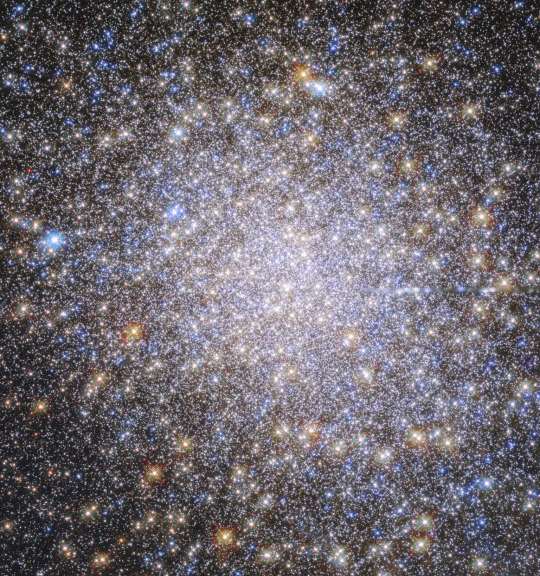
When is a globular cluster, not globular but oblate (flattened orb, similar to the shape of the Earth) ? When it's light is extinct !

The second lower resolution image shows that the cluster appears to be not quite circular, but rather flattened.
However it is suggested that is not quite the case, light is playing tricks through extinction, or better put, the light is being absorbed by dust and gas between us and it, some 28,500 light years from Earth, and is causing this illusion of flatness. When viewed in IR, it appears quite globular.
31 notes
·
View notes
Text
M18 - The Black Swan Cluster
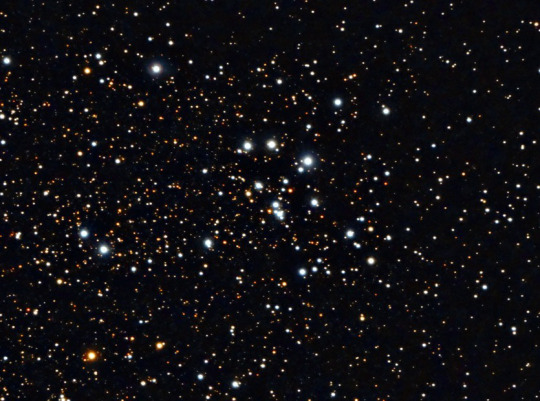
Not so far in the sky from both M16 and M17 lies the black swan cluster, a group of stars left behind after the dust and gas from the nebula has left the scene.
Stars remain in their cluster formation long after, the B and O type blue giant stars for most if not all of their life time, because they don't live long enough to escape but also their mass is stronger making it that bit harder to be ejected by gravitational encounter (although, certainly not unheard of).
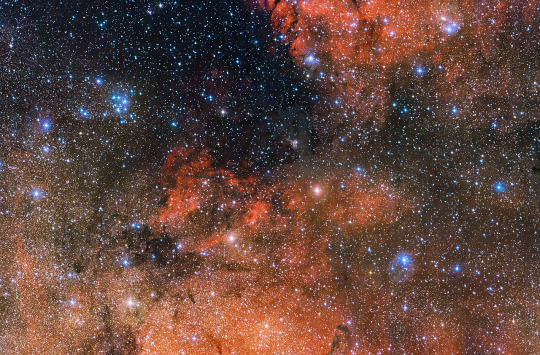
In this image from VLT's OmegaCam you can see the cluster (top left) but you can also see it's set against the backdrop of the milky way, and other areas of dust and gas where star formation still continues.
The cluster sits 4,230 light years from Earth in the constellation of Sagittarius.
41 notes
·
View notes
Text
Messier 17

M17 has a number of given names, The Omega Nebula, The Swan Nebula, Checkmark or Horseshoe Nebula and my own personal favorite, the Lobster Nebula.

It's located not so far from M16 - Eagle nebula, and has the similar columns and star formation features as it too.
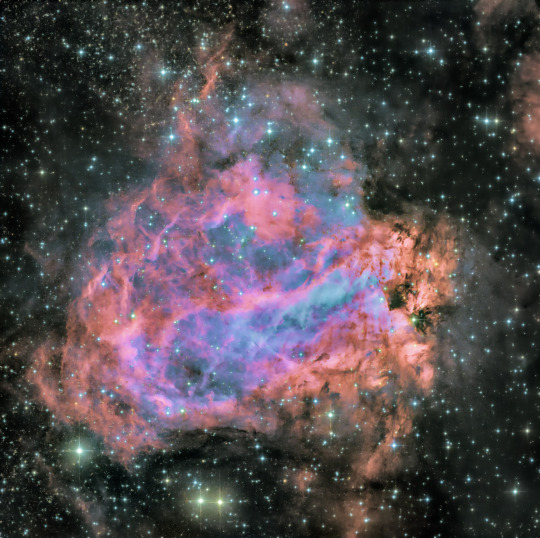
Different filters are used to highlight the different chemicals in the nebula, but also show up some of the stars not so easily visible in the upper image.
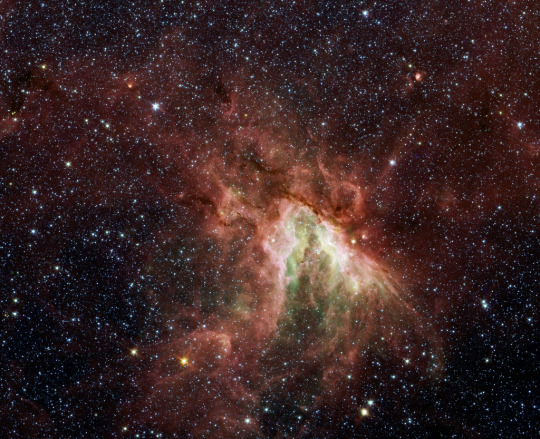
Infra red images see straight through much of the concealing dark nebula areas and show the areas where most star formation is going on. It also highlights the stars this nebula sits over, the milky way in the background of Sagittarius.
27 notes
·
View notes
Text
Messier 16 - The Eagle Nebula
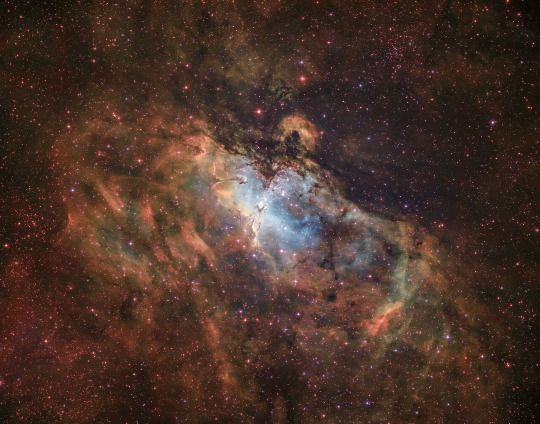
5,700 light years away in the constellation of Serpens lies this iconic area of star formation, an open cluster, but also an emissions nebula with a web of dark dust strands and columns.
Made famous by Hubble in the "Pillars of Creation" image.
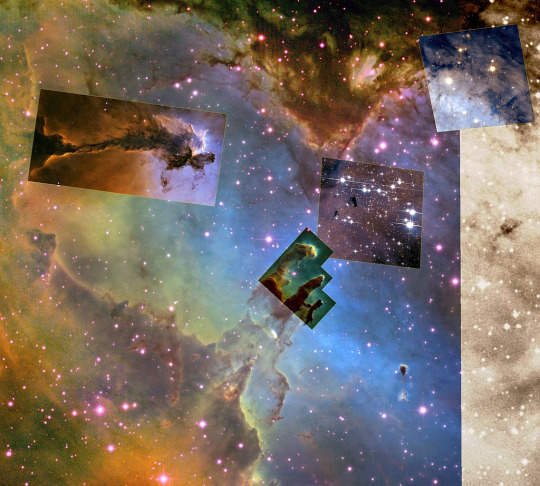
The cluster itself has an estimated 8,100 stars and is thought to be between 1 and 2 million years old. The brightest star HD168076 is two O type stars in binary partnership, some 80 times the mass of our star, and 1 million times brighter.
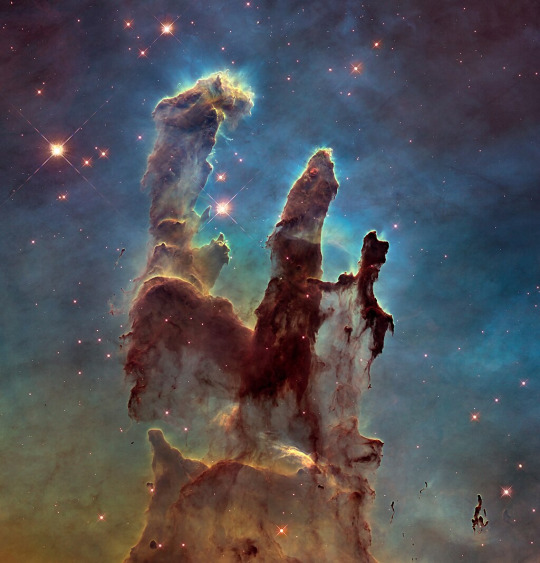
The classic columns with their bright tips is seen in many nebulous regions, and is thought to contain proto stars developing inside.

And another larger example, thought to extend over 9.5 light years.
The structure is just out of reach of naked eyes, but visible in binoculars or small telescopes, but don't expect to see this kind of detail, a smudge may be the best you'll see.
43 notes
·
View notes
Text
Messiers Globular Clusters 12 to 15
Messier seems to have a thing for Globular clusters, at least at the start of his catalogue, although to be fair to him, his comments on these objects explains this somewhat.

This Messier described M12 as "A nebula without stars!"
It's easy to forget in a time of Hubble and JWST that Messier was dealing with instruments not that much better than a good pair of binoculars, and to him the object looked like a giant fuzzy patch, with no individual stars showing.
Messier 12 is odd in that it has a surprisingly low amount of the longest lived low mass stars (red dwarfs, K and G type stars), and with an age of 13.8 billion years old (pretty much the age of the universe itself), it's clearly passed through the milky way so many times, many of the lower mass stars have been ejected or found themselves pulled away, and likely now still live on in the central bulge.
M13 - The Great Hercules Cluster
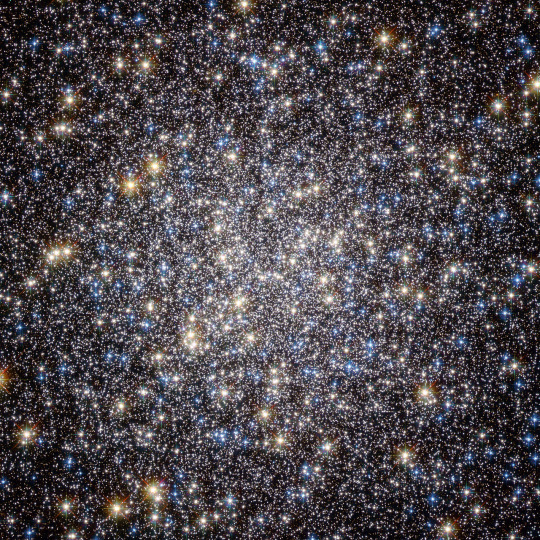
The brightest of the stars in this cluster are the red giants, one in particular V1554 Hercules has an apparent mag 11.95 from 23,000 light years.
Interestingly, there's some blue stars here, but they are not young hot B or O type stars you find in Open Clusters, they are what are known as blue stragglers. Stars are so compressed in the heart of globular clusters that they do regularly merge, and when that happens, a blue straggler can be the product.
M14

Some 30,000 light years away from us in the constellation of Ophiuchus, it's 100 light years across and in total, 400,000 times the mass of our star, 10 times less than the supermassive black hole Sag A*.
M15 - The Great Pegasus Cluster

One of the most densely packed globular clusters known, so much so, the core (central region) has begin to contract in what is known as core collapse, where the mass of stars is so intense, it begins to pull in mass from around it, and most likely forming a intermediate black-hole, although none has ever been confirmed as such.
It is also the only globular cluster to ever be found to have a planetary nebula, Pease 1
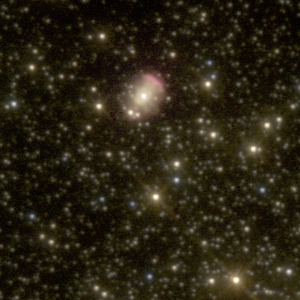
43 notes
·
View notes
Text
2 Globular Clusters and a Wild Duck
M9, M10 & M11

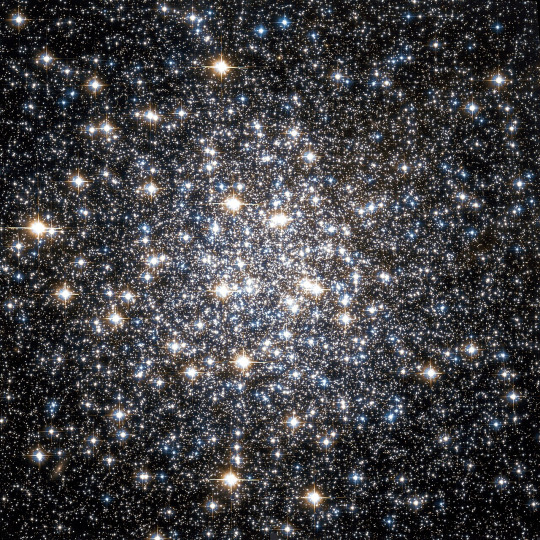

Messier 9 & 10 are globular clusters, ancient objects at 12 and 11.3 billion years old respectively.
Both clusters are in the constellation of Ophiuchus, although at different distances, with M10 being much closer at 17,000 light years, while M9 is further out at 25,800 light years.
Globular clusters tend to follow eccentric orbits around the galaxy, moving out of the galaxy plane and into the halo, and then returning back through the galaxy and out the other side.

M11 may look like a globular cluster, but it's an open cluster, the difference being it's formed in a nebula and often much more recently.
It's similarity to globular clusters however is mostly because it is one of the most massive and compact open clusters known, but the colour is a give-away, young star clusters tend to visibly be dominated by blue giant stars, they don't last too long in the scheme of things, and then return much dust and gas back into the environment for more stars to form from.
It sits 6,100 light years from Earth in the constellation of Scutum, and is right at the limit of being a naked eye object, better viewed through binoculars or telescopes.
32 notes
·
View notes
Text
Messier 8 - The Lagoon Nebula

One of only 2 nebula visible to the naked eye (although at mag 4.6 you're not going to see anything like the above image, just a smudge in the sky) and star forming regions.
It's located 4-6,000 light years from Earth in the constellation of Sagittarius.
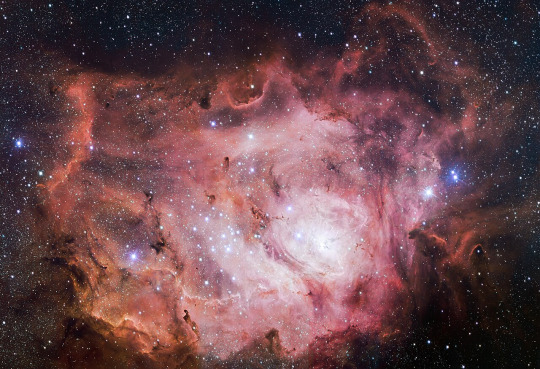
The nebula is an emissions nebula which means the hydrogen emits the pink/red light when bombarded by UV light from the stars within it, and there are a number of young clusters of stars within, some visible and others not so much.

Infra red telescopes can peer through the dust and gas and reveal the stars within.
But so far, some of the best images have come from Hubble including the one at the top, and this one.

42 notes
·
View notes
Text
Messier 7 - Ptolemy Cluster

The furthest south of Messier's objects at -34.8'S simply because in Messier's day, travel took months and was out of reach for most people.
The cluster was known about in antiquity, and as it's name suggests, the Greek (with Roman citizenship) Astronomer Ptolemy is the first to reference it as a nebula, but being an naked eye object, it will have been seen by humans since the dawn of mankind, particularly in the southern hemisphere.
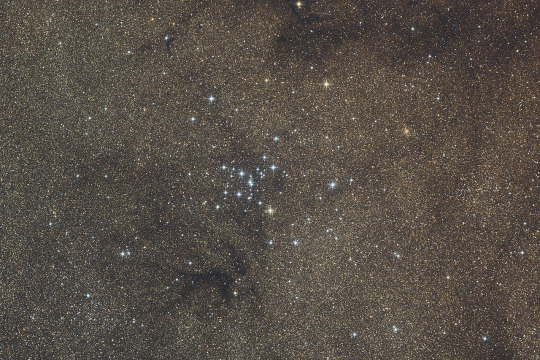
It sits over the backdrop of the Milky Way itself, giving an amazing backdrop of billions of stars.
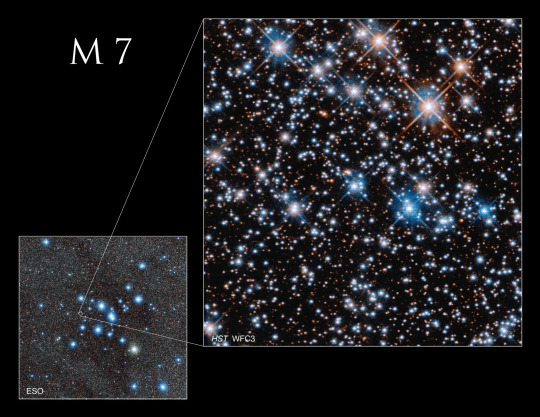
Like most clusters, the blue stars stand out most, due to their brightness, but look closer (as Hubble did above) then you can see there are many smaller long living stars within the cluster.

The whole structure is around 25 light years across, and 980 light years from Earth in the constellation of Scorpius and is estimated to be around 200 million years old.
53 notes
·
View notes
Text
Messier 6 - The Butterfly Cluster
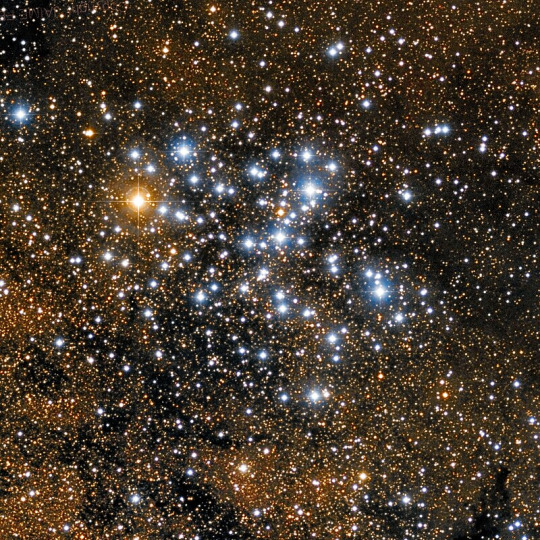
One of the few remaining Messier objects that hasn't been photo'd by Hubble, this open cluster is in the constellation of Scorpius and lies around 1,500 light years from Earth.
It's also one of the few Messier objects at Mag 4.6 you can indeed see with the naked eye.

The brightest star is the K type orange giant BM Scorpii, one of the blue giants that's fallen off the main sequence and is now aging. The entire cluster is thought to be around 94.2 million years old, so it's likely it has lost a few to supernova in the past. The orange star contrasts with the younger B type stars blue.

Most stars are born in such clusters, from Earth the blue giants stand out most, but there is estimated to be over 120 stars in this cluster, many other clusters can be thousands of stars, most being smaller and longer lived, like our own star.
When the nebula has long gone, the stars remained gravitationally bound to each other in these cluster formations, although after a few hundred million years the large blue giants will have collapsed and the longer lived stars may eventually find their own way around the galaxy, if they are not flung out before this by a close call to a much larger star.
32 notes
·
View notes
Text
Messier 5 - The Rose Cluster
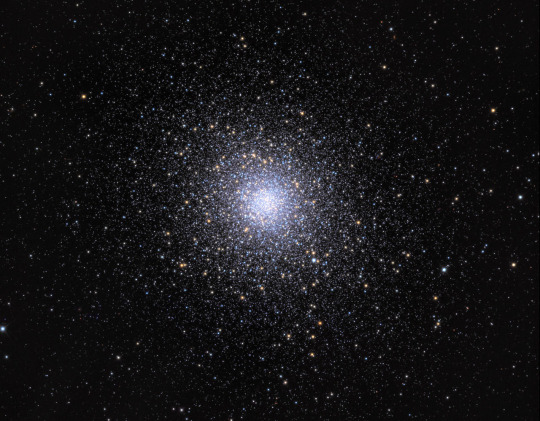
The milky way has over 150 globular clusters, and while most look alike, each has it's own history and mystery to untangle.
It's 24,500 light years from Earth in the constellation of Serpens, and moving away from us currently at around 50km/s. This is because globular clusters tend to have orbits that leave the main plain of the galaxy disk and orbit in and around the halo of lightly populated stars. It is thought that the cluster containers over 100,000 stars all crushed into 165 light years.

Globular clusters are useful for measuring distance, variable stars inside of the cluster that have predictable patterns can provide very accurate distances.
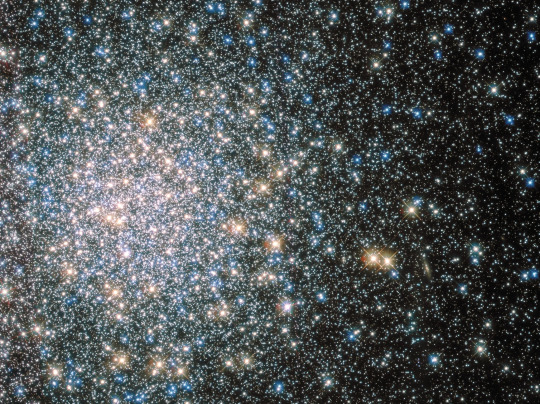
The M5 also has one star that experiences what's classified as a dwarf nova, a binary system with a white dwarf that pulls material from it's main sequence partner, then explodes when it reaches a particular density. Dwarf nova are the same as standard nova's (not to be confused with supernova) but just have shorter time periods between explosion.

31 notes
·
View notes
Text
Messier 4 - The Closest Globular Cluster to Earth
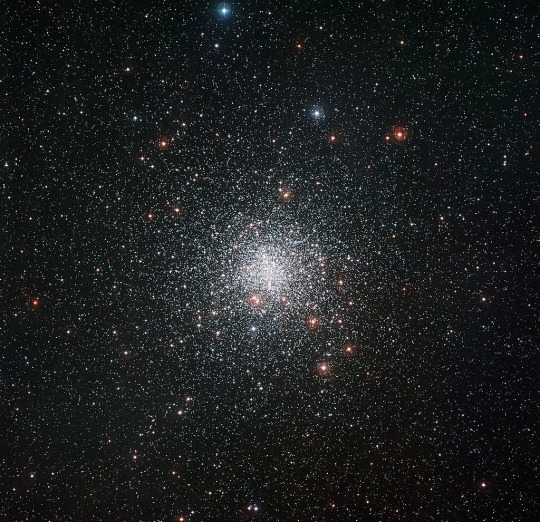
At around 6,000 light years from Earth, this is the closest globular cluster to us, but is likely a shadow of it's former self.
It's orbit takes it through the dense core of our Milky Way, and as a result, the tidal shock waves as it does peels off more and more stars.
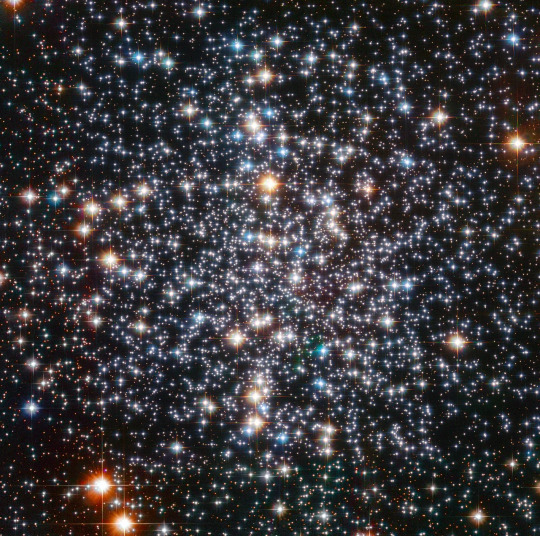
One benefit of it's closeness (most globular clusters are 20-30kly from us) is the array of telescopes we've had available since Hubble onwards have been able to record not only individual stars, white dwarfs, neutron stars and pulsars, but even planets in some cases around those stars.

Additionally, close monitoring of the central region of this 75 light year wide group of stars has shown what looks like a mass of around 800 suns, and is thought to be the best example of an intermediate black hole to-date, although it cannot be ruled out that it's a large amount of stellar black holes, neutron stars and white dwarfs that is making up this central mass. The above gif shows observations of stars slightly changing their direction as they move close to the centre.
41 notes
·
View notes
Text
Messier 3 - Globular Cluster

Considered one of the finest northern hemisphere globular clusters, Messier 3 contains 500,000 stars all crushed into 90 light years, when you consider there are around 60,000 stars within 100 light years of us, it gives you an idea, almost 10 times more stars packed into the same space, but far more towards the central region.
The cluster is 33,900 light years from Earth and far above the normal spiral plane of our galaxy, putting it in the halo area where few stars exist.
It's the archetypal Oosterhoff type I globular cluster, a cluster that's old but has high metallicity for a globular cluster, still only 3-4% of what our sun has.

It's position in Canes Venatici makes it fairly easy to see for those with binoculars in the north, but at 6.2 mag, it's just outside of most people's naked eye sight, although if you use averted vision (see through the side of your eyes) in a very dark location, then you may just glimpse a smudge (assuming you've already got very good eye sight).
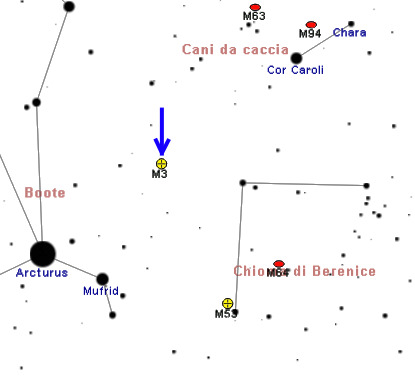
The cluster is not so far from Arcturus, between it and Cor Caroli.
34 notes
·
View notes
Text
Messier 2 - Globular Cluster
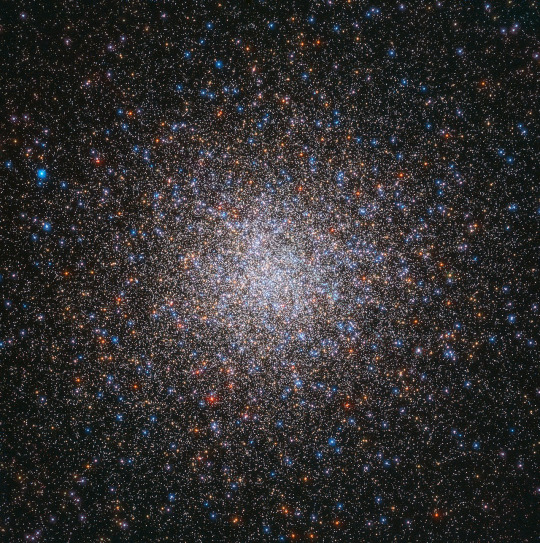
55,000 light years away in the constellation of Aquarius, 150,000 stars crushed into a 150 light years area form this amazing globular cluster. Recent observations has noted streams of stars extending out another 300 light years, thought to be tidally effected by the large magellanic clouds.

The object is thought to be 12.5 billion years old, one of the oldest objects in our galaxy, and the brightest stars are all giant red or yellow, stars like our own sun reaching the end of their lives.
One mystery about this cluster is the higher than expected metallicity, particularly for it's long age, it is thought that this cluster along with a number of others come from what is collectively known as the Gaian Sausage.

A collection of mostly halo objects all that are thought to have come from a galaxy merger 10-11 billion years ago with our milky way. It could be part of the remnants of a galaxy bulge long since merged and mixed up.

M2 is visible with binoculars, and so a good one to go looking for, it's position making it fairly easy to observe both north and south.
38 notes
·
View notes
Text
Messier 1 - The Crab Nebula
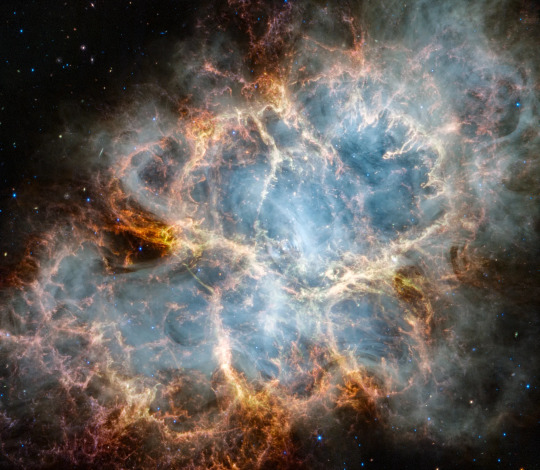
On the 4th July 1054, Chinese and Japanese astronomers saw and recorded a new light in the sky, in what we know as the constellation of Taurus (Chinese and Japanese constellations do differ). The star was for a while so bright that it was visible during the day, before fading away.
It wasn't seen again until 1731, although by telescope, and it was another 200 years almost before the link between the 1054 observations and the Crab Nebula were linked.

The first images drawn of the nebula were not quite as we see them today, and probably represents a distortion due to low resolution and movement and fanciful artistic license (modern artist impressions are no more accurate, albeit a bit more colourful).

This classic Hubble image of the Crab Nebula gave a lot more detail to the structure and chemical composition of the nebula, although when mixed with other kinds of telescope (composite), a lot more detail outside of the human eye's capability becomes apparent.

This composition between Hubble and Chandra (X-Ray) shows the area around the remnant pulsar.
One interesting mystery surrounding the Crab Nebula is the missing mass. For a supernova to occur, a critical mass needs to be attained, otherwise like our own star, it will end it's life as a planetary nebula.
When taken into account the mass seen and in the remnant objects at the centre, only 5 times the mass of the Sun can be accounted for, which means a supernova should not had happened.
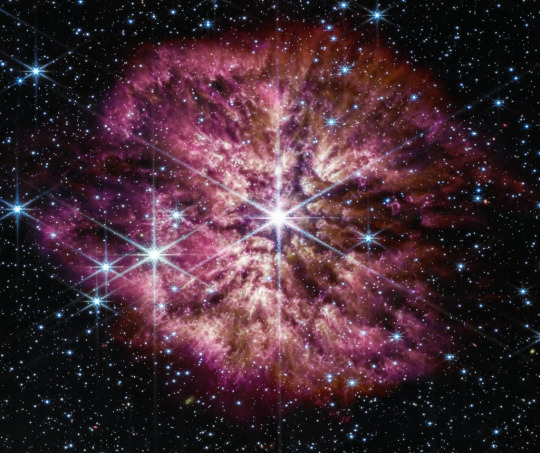
One theory is, that the progenitor was a Wolf Rayet star, that long before it went supernova, had been constantly dumping huge amounts of material and so let the mass reduce substantially before going supernova. However, no visible shell has ever been found around the nebula, so it's possible the star was a very special kind of supernova, not one of the common 1a / 2 types seen most often.
49 notes
·
View notes
Text
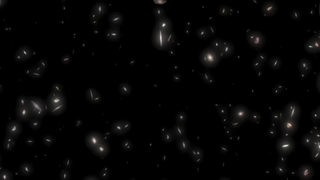
Is Dark Energy Constant
To start off, what is known as "Dark Energy", as it's not the same as Dark Matter, although I think you can replace the term "Dark" with "No idea" and that would work in both cases.
Dark energy is the force that keeps the universe expanding, I like to think of it as the air you blow into the balloon, that then sends any markings on the surface of the balloon shooting apart.

In the case of the balloon, the surface expansion is fairly constant throughout (assuming it's a spherical balloon), and this has been part of the conversation in astronomy, we see the galaxies moving apart, but is this happening at a constant rate ?
It's hard enough just reading the speed at which the universe is expanding, the Hubble tension is exactly that, a difference between readings when you use different methodologies, and that makes it harder to be sure if this expansion is uniform or not, when you have such a high degree of error in the reading.
Up step DESI (Dark Energy Spectroscopic Instrument)
Desi has been busy mapping distant objects and looking at the light to see what changes have occurred in the light, and to see if this is uniform.

The changes in the light as it passes through closer objects, can tell us a huge amount about them.
The instrument has collected millions of points of data over the last few years, and has begun to create a map of the structure of the universe, and the data has shown one interesting feature.

It's thought that there is a 1 in 400 chance of error (which is not Sig 5 but it's still pretty good certainty) but the data appears to show there is a difference in the speed that galaxies are moving apart, particularly over time, and it may be possible that dark energy is not constant, but is changing.
Why is this important ? Well, if you've ever wondered about the ultimate fate of our universe (which you may not have done, granted), dark energy is one of the most important variables you'll want to know.

The above assumes a constant expansion, but if this isn't true, then the fate of the universe is not certain at all, and opens the possibility for many other theories to predict something no human can ever be alive to qualify.
We are truly living in a period in astronomy of large changes in our understanding of what were once old near certainties, tools such as DESI and JWST are helping us for the first time test assumptions, and of course, from time to time, we're going to find out our best ideas were but a mere pale shadow of the reality.
21 notes
·
View notes
Text

The Umbrella Galaxy NGC 4651
It's raining stars in NGC 4651, but the umbrella isn't stopping it, the umbrella is the stars.
What on the surface looks like a fairly normal spiral galaxy, has this 100,000 light years long arm with an arc at the outer edge. How did this get here ?
Just like our own galaxy, that has smaller dwarf galaxies orbiting around 150,000 light years out, this one appears to have suddenly merged with one, maybe due to gravitational interactions with other galaxies, or that the dwarf galaxy wasn't in a stable orbit and ultimately would have fallen in one way or another.
Eventually the stars will settle into a new home, but in the mean time, the galaxy will sport an umbrella for many more million years to come.
104 notes
·
View notes